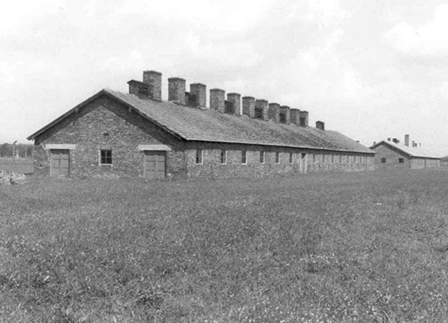Overview
- Brief Narrative
- Compass owned by 17-year-old Leon Apfel, a drawing student in Antwerp, Belgium, before World War II. Leon’s 10-year-old sister, Lea, admired the compass and took it with her in 1942 when she was sent into hiding with a Catholic family as the Germans were rounding up the Jews of Belgium for deportation to concentration camps. The compass was the only family possession that survived with her. Leon had fled Belgium before the round-ups and tried to make his way to Switzerland, but was captured in France, imprisoned in the Drancy transfer camp, and on September 18, 1942, deported to Auschwitz. On October 24 of that year, their parents were deported to Auschwitz from Belgium. All three were killed in the camp.
- Date
-
use:
1942
- Geography
-
use:
Antwerp (Belgium)
- Credit Line
- United States Holocaust Memorial Museum Collection, Gift of Lea Bierlaire-Apfel
- Markings
- b. side of hinge, engraved : REUGHEL
c. tip of cylinder, stamped : 6 (or 9?) - Contributor
-
Subject:
Lea Apfel-Bierlaire
Subject: Leon Apfel
- Biography
-
Lea Apfel was born in October 1931 in Antwerp, Belgium. Her parents were Rivka Feuer, born 1897, and Samson, born 1899. She had one brother, Leon, who was born on March 25, 1925. The family had moved to Belgium from Przemysl, Poland, in 1929 or 1930. In Antwerp, her father had a soda water business. In 1940, Germany invaded Belgium and instituted anti-Jewish measures. Lea’s brother tried to escape to Switzerland, but was caught in France and imprisoned in the Drancy transit camp, then deported to Auschwitz-Birkenau concentration camp. On September 18, 1942, Lea’s parents arranged through a neighbor to have Lea hidden with a Catholic family. Her parents were deported to the Mechelen transit camp on October 24, 1942, and later to Auschwitz-Birkenau. Lea was hidden in a room through the rest of the war. Afterward, she lived in a Jewish home for children. Her parents and brother did not survive.
Leon Apfel was born March 25, 1925, in Przemysl, Poland. His parents, Rivka Feuer, born 1897, and Samson, born December 8, 1899, also were born in Przemysl. The family moved to Antwerp, Belgium, in 1929 or 1930, where Leon’s sister, Lea, was born in October 1931. In Antwerp, his father had a soda water/fruit drinks business. In 1940, Germany invaded Belgium and instituted anti-Jewish measures. Leon tried to escape to Switzerland, but was caught in France and imprisoned in the Drancy transit camp, then on September 18, 1942, deported to Auschwitz-Birkenau concentration camp. On October 24, 1942, his parents were deported from Antwerp to the Mechelen transit camp, and later to Auschwitz-Birkenau. His sister was hidden by a Catholic family and survived. Leon and his parents were killed at Auschwitz.
Physical Details
- Classification
-
Tools and Equipment
- Category
-
Measuring instruments
- Object Type
-
Compasses (drawing instruments) (aat)
- Physical Description
- a. Rectangular, wooden case with rounded corners, partially covered with black paper textured to resemble leather. The interior is lined with velvet-like cloth that also acts as the hinge. The interior bottom has 5 grooves, 1 full-length and 3 half-length, to hold the instruments. The metal nail closure slides through a hole in the front right corner, through a ring in the center top to fit into a notch in the center bottom. When the nail is pushed in the case locks.
b. Silver-colored, metal compass with 2 moveable, cylindrical legs, connected by a round, thumbscrew hinge, and a cylindrical handle with vertical grooves. Each leg flattens at the top and has a thumbscrew adjustment half way down. The tip of one leg has a sharp point; the other has a bracket to hold a short length of graphite. Both tips have adjusting knobs. One word of text is engraved on the side of the hinge.
c. Silver-colored, metal cylinder that separates at a beaded ring in the middle. It contains 2 short lengths of graphite. A number is stamped on the end. - Dimensions
- a: Height: 1.000 inches (2.54 cm) | Width: 7.000 inches (17.78 cm) | Depth: 2.250 inches (5.715 cm)
b: Height: 6.120 inches (15.545 cm) | Width: 0.500 inches (1.27 cm) | Depth: 0.500 inches (1.27 cm)
c: Height: 1.380 inches (3.505 cm) | Diameter: 0.250 inches (0.635 cm) - Materials
- a : wood, cloth, metal, paper, adhesive
b : metal, graphite, metal
c : graphite
Rights & Restrictions
- Conditions on Access
- No restrictions on access
- Conditions on Use
- No restrictions on use
Keywords & Subjects
Administrative Notes
- Legal Status
- Permanent Collection
- Provenance
- The compass was donated to the United States Holocaust Memorial Museum in 2005 by Lea Apfel-Bierlaire, the sister of Leon Apfel.
- Record last modified:
- 2022-07-28 18:29:55
- This page:
- http://collections.ushmm.org/search/catalog/irn523199
Download & Licensing
In-Person Research
- By Appointment
- Request 21 Days in Advance of Visit
- Plan a Research Visit
- Request to See This Object
Contact Us
Also in Leon Apfel collection
The collection consists of a compass and case and a photograph relating to the experiences of Leon Apfel and Lea Apfel-Bierlaire before and during the Holocaust.
Date: 1942
Photograph of Leon Apfel
Document
The copyprint photograph depicts Leon Apfel. Unknown photographer. Leon Apfel was born inPrzemysl, Poland, to Rivka Feuer (b. 1897) and Samson (b. 1899). His sister Lea (b. 1931) was born in Belgium, where the family moved in 1929 or 1930. Following the German invasion of Belgium, Leon attempted to escape to Switzerland but was caught in France. He was deported to Drancy and then to Auschwitz and did not survive. His parents were deported to the Mechelen transit camp in 1942 and then to Auschwitz-Birkenau and did not survive. His sister Lea survived in hiding with a Catholic family.



